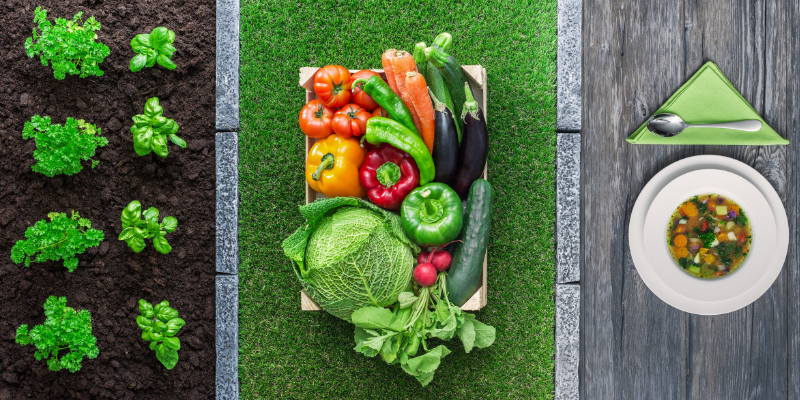Farm to Table: Chemical Edition
By Jillian Jastrzembski

It has become trendy to think about the farm-to-table trajectory of our food. We think about land use, the exploitation of farm workers, the use of pesticides, and whether or not our meat had a happy life. These considerations are critical because of their ethical and health implications with respect to the well-being of everyone in the production chain, the well-being of the environment, and the well-being of the consumer. But what about the farm-to-lab trajectory of chemical reagents? Specifically, does it matter if high purity, food grade ethanol derives from corn, or from sugarcane?
Many consumers prefer grass-fed beef because cows evolved to eat grass. When the cow is forced to eat corn instead, it develops disease, resulting in the need for antibiotics. Nevertheless, corn-fed beef is still the norm in the United States since corn is so abundant. Analogously, in the US we use corn to produce ethanol in lieu of more optimal substrates such as sugarcane or sugar beet. In this case, corn is being “fed” not to cows but to yeast, and as with beef cows, a multitude of additional steps is required to overcome its shortcomings.
Since there aren’t any vegans advocating for the well-being of the yeast cells used in fermentation (yet), let’s first consider – in isolation – the quality of the resulting product, in this case, ethanol. Should it matter if ethanol comes from sugar or from corn? By the time high purity, food grade ethanol is in the hands of the chemist, it is essential that the answer be a definitive no, it cannot matter where it came from – because if the answer is yes, it means that there are impurities remaining in the solvent. Analytical integrity demands high purity so that there will not be interferences from the solvent system, or potential damage to instrumentation. Sensory integrity demands high purity so that there will not be flavor interferences or health hazards to consumers. Therefore, high purity food grade ethanol gives no clues as to its origin. It is 100% ethyl alcohol, a 2-carbon chain alcohol. It is impossible to tell that it was a plant in a former life – let alone which plant.

Nevertheless, in the spirit of the farm-to-table movement, let’s humor the idea that nothing happens in isolation (since it’s probably true), and invent a sordid past for this versatile solvent.
The first step in the supply chain is agriculture. Interestingly, the United States is the world’s leading producer of ethanol and beef – both produced using corn. Brazil is the number two producer for both commodities, but unlike the US, most of the beef is grass-fed. Also unlike the US, the primary feedstock for Brazilian ethanol is sugarcane, which suggests superior sustainability of Brazilian ethanol. Sugar cane has better yields, lower water and fertilization requirements, better climate adaptability, and shorter crop cycle duration compared to corn.
However, since a small minority of total ethanol production globally goes to non-fuel ethanol, and an even smaller proportion of that goes to “high value” ethanol (high purity, food grade), the agricultural concerns of lab ethanol is arguably trivial relative to that of fuel ethanol. Moreover, as a biofuel, ethanol has other advantages. First of all, it has a built-in carbon offset – the crops that will later be converted to ethanol help to mitigate carbon dioxide levels in the atmosphere. Secondly, the byproducts of ethanol production are used as feedstock for farmed animals. With this in mind, let’s move on to consider the next step in the supply chain: the actual production process.

Ethanol is produced through fermentation of sugar, which means that it can derive from any source of carbohydrate. Sugar from sugarcane is a simple carbohydrate (sucrose) that is readily broken down by yeast to produce ethanol with few byproducts, making both preparation and subsequent purification a relatively efficient procedure. Corn, on the other hand, requires more intensive preparatory steps prior to fermentation, including energy-intensive wet-milling in order to extract starch from the other components of the grain. Starch is complex carbohydrate, which requires depolymerization to produce glucose before it can be broken down by yeast cells. Furthermore, fermentation of starch results in a slew of byproducts which need to be removed in subsequent steps. Short chain fatty acids, esters, and aldehydes are all types of volatile organic compounds that can impart undesirable aromas even at trace levels, sometimes on the order of parts per trillion. Phenol, benzoic acid, and styrene are examples of cyclic and aromatic compounds that pose a risk to consumer health. All impurities compromise analytical integrity because they may create interferences during analysis.
So technically yes, sugar-based ethanol is arguably superior in terms of agricultural and production efficiency. That said, food grade ethanol represents less than 3% of United States ethanol production, which means there are higher-impact ways to improve sustainability and efficiency. If the analytical chemist cannot tell the difference between corn-based ethanol and sugarcane-based ethanol, probably no one else is complaining.
References
Taking ethanol quality beyond fuel grade: A review
https://doi.org/10.1002/jib.364
The Omnivore’s Dilemma (book), by Michael Pollan
Renewable Fuels Association
The origin, supply chain, and deforestation risk of Brazil’s beef exports
https://www.pnas.org/doi/10.1073/pnas.2003270117

